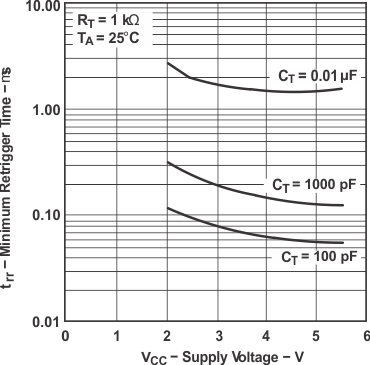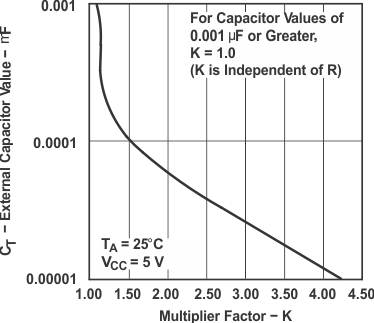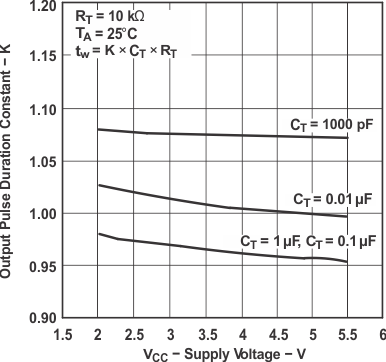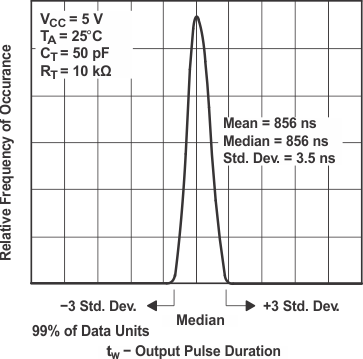SCLS393Q APRIL 1998 – August 2015 SN74LV123A
UNLESS OTHERWISE NOTED, this document contains PRODUCTION DATA.
- 1 Features
- 2 Applications
- 3 Description
- 4 Revision History
- 5 Description (continued)
- 6 Pin Configuration and Functions
-
7 Specifications
- 7.1 Absolute Maximum Ratings
- 7.2 ESD Ratings
- 7.3 Recommended Operating Conditions
- 7.4 Thermal Information
- 7.5 Electrical Characteristics
- 7.6 Timing Requirements, VCC = 2.5 V ± 0.2 V
- 7.7 Timing Requirements, VCC = 3.3 V ± 0.3 V
- 7.8 Timing Requirements, VCC = 5 V ± 0.5 V
- 7.9 Switching Characteristics, VCC = 2.5 V ± 0.2 V
- 7.10 Switching Characteristics, VCC = 3.3 V ± 0.3 V
- 7.11 Switching Characteristics, VCC = 5 V ± 0.5 V
- 7.12 Operating Characteristics
- 7.13 Typical Characteristics
- 8 Parameter Measurement Information
- 9 Detailed Description
- 10Application and Implementation
- 11Power Supply Recommendations
- 12Layout
- 13Device and Documentation Support
- 14Mechanical, Packaging, and Orderable Information
封装选项
机械数据 (封装 | 引脚)
散热焊盘机械数据 (封装 | 引脚)
- RGY|16
订购信息
7 Specifications
7.1 Absolute Maximum Ratings
over operating free-air temperature (unless otherwise noted)(1)| MIN | MAX | UNIT | |||
|---|---|---|---|---|---|
| VCC | Supply voltage | –0.5 | 7 | V | |
| VI | Input voltage(2) | –0.5 | 7 | V | |
| VO | Voltage applied to any output in the high-impedance or power-off state(2) | –0.5 | 7 | V | |
| VO | Output voltage in the high or low state(2)(3) | –0.5 | VCC + 0.5 | V | |
| VO | Output voltage in power-off state(2) | –0.5 | 7 | V | |
| IIK | Input clamp current | VI < 0 | –20 | mA | |
| IOK | Output clamp current | VO < 0 | –50 | mA | |
| IO | Continuous output current | VO = 0 to VCC | ±25 | mA | |
| Continuous current through VCC or GND | ±50 | mA | |||
| Tj | Junction temperature | 150 | °C | ||
| Tstg | Storage temperature | –65 | 150 | °C | |
(1) Stresses beyond those listed under Absolute Maximum Ratings may cause permanent damage to the device. These are stress ratings only, and functional operation of the device at these or any other conditions beyond those indicated under Recommended Operating Conditions is not implied. Exposure to absolute-maximum-rated conditions for extended periods may affect device reliability.
(2) The input and output negative-voltage ratings may be exceeded if the input and output current ratings are observed.
(3) The value is limited to 5.5 V maximum.
7.2 ESD Ratings
| VALUE | UNIT | |||
|---|---|---|---|---|
| V(ESD) | Electrostatic discharge | Human body model (HBM), per ANSI/ESDA/JEDEC JS-001(1) | ±2000 | V |
| Charged-device model (CDM), per JEDEC specification JESD22-C101(2) | ±1000 | |||
(1) JEDEC document JEP155 states that 500-V HBM allows safe manufacturing with a standard ESD control process.
(2) JEDEC document JEP157 states that 250-V CDM allows safe manufacturing with a standard ESD control process.
7.3 Recommended Operating Conditions
See (1).| SN54LV123A(2) | SN74LV123A | UNIT | |||||||
|---|---|---|---|---|---|---|---|---|---|
| MIN | NOM | MAX | MIN | NOM | MAX | ||||
| VCC | Supply voltage | 2 | 5.5 | 2 | 5.5 | V | |||
| VIH | High-level input voltage | VCC = 2 V | 1.5 | 1.5 | V | ||||
| VCC = 2.3 V to 2.7 V | VCC × 0.7 | VCC × 0.7 | |||||||
| VCC = 3 V to 3.6 V | VCC × 0.7 | VCC × 0.7 | |||||||
| VCC = 4.5 V to 5.5 V | VCC × 0.7 | VCC × 0.7 | |||||||
| VIL | Low-level input voltage | VCC = 2 V | 0.5 | 0.5 | V | ||||
| VCC = 2.3 V to 2.7 V | VCC × 0.3 | VCC × 0.3 | |||||||
| VCC = 3 V to 3.6 V | VCC × 0.3 | VCC × 0.3 | |||||||
| VCC = 4.5 V to 5.5 V | VCC × 0.3 | VCC × 0.3 | |||||||
| VI | Input voltage | 0 | 5.5 | 0 | 5.5 | V | |||
| VO | Output voltage | 0 | VCC | 0 | VCC | V | |||
| IOH | High-level output current | VCC = 2 V | –50 | –50 | µA | ||||
| VCC = 2.3 V to 2.7 V | –2 | –2 | mA | ||||||
| VCC = 3 V to 3.6 V | –6 | –6 | |||||||
| VCC = 4.5 V to 5.5 V | –12 | –12 | |||||||
| IOL | Low-level output current | VCC = 2 V | 50 | 50 | µA | ||||
| VCC = 2.3 V to 2.7 V | 2 | 2 | mA | ||||||
| VCC = 3 V to 3.6 V | 6 | 6 | |||||||
| VCC = 4.5 V to 5.5 V | 12 | 12 | |||||||
| Rext | External timing resistance | VCC = 2 V | 5 | 5 | kΩ | ||||
| VCC ≥ 3 V | 1 | 1 | |||||||
| Cext | External timing capacitance | No restriction | No restriction | pF | |||||
| Δt/ΔVCC | Power-up ramp rate | 1 | 1 | ms/V | |||||
| TA | Operating free-air temperature | –55 | 125 | –40 | 125 | °C | |||
(1) All unused inputs of the device must be held at VCC or GND to ensure proper device operation. Refer to the TI application report, Implications of Slow or Floating CMOS Inputs, SCBA004.
(2) Product Preview
7.4 Thermal Information
| THERMAL METRIC(1) | SNx4LV123A | UNIT | ||||||
|---|---|---|---|---|---|---|---|---|
| D (SOIC) | DB (SSOP) | DGV (TVSOP) | NS (SO) | PW (TSSOP) | RGY (VQFN) | |||
| 16 PINS | 16 PINS | 16 PINS | 16 PINS | 16 PINS | 16 PINS | |||
| RθJA | Junction-to-ambient thermal resistance | 73 | 82 | 120 | 64 | 108 | 39 | °C/W |
(1) For more information about traditional and new thermal metrics, see the Semiconductor and IC Package Thermal Metrics application report, SPRA953.
7.5 Electrical Characteristics
over recommended operating free-air temperature range (unless otherwise noted)| PARAMETER | TEST CONDITIONS | VCC | –55°C to 125°C SN54LV123A(2) |
–40°C to 85°C SN74LV123A |
Recommended –40°C to 125°C SN74LV123A |
UNIT | ||||||||
|---|---|---|---|---|---|---|---|---|---|---|---|---|---|---|
| MIN | TYP | MAX | MIN | TYP | MAX | MIN | TYP | MAX | ||||||
| VOH | IOH = –50 µA | 2 V to 5.5 V |
VCC – 0.1 | VCC – 0.1 | VCC – 0.1 | V | ||||||||
| IOH = –2 mA | 2.3 V | 2 | 2 | 2 | ||||||||||
| IOH = –6 mA | 3 V | 2.48 | 2.48 | 2.48 | ||||||||||
| IOH = –12 mA | 4.5 V | 3.8 | 3.8 | 3.8 | ||||||||||
| VOL | IOL = 50 µA | 2 V to 5.5 V |
0.1 | 0.1 | 0.1 | V | ||||||||
| IOL = 2 mA | 2.3 V | 0.4 | 0.4 | 0.4 | ||||||||||
| IOL = 6 mA | 3 V | 0.44 | 0.44 | 0.44 | ||||||||||
| IOL = 12 mA | 4.5 V | 0.55 | 0.55 | 0.55 | ||||||||||
| II | Rext/Cext(1) | VI = 5.5 V or GND | 5.5 V | ±2.5 | ±2.5 | ±25 | µA | |||||||
| A, B, and CLR | VI = 5.5 V or GND | 0 V | ±1 | ±1 | ±1 | |||||||||
| 0 to 5.5 V |
±1 | ±1 | ±1 | |||||||||||
| ICC | Quiescent | VI = VCC or GND, | IO = 0 | 5.5 V | 20 | 20 | 20 | µA | ||||||
| ICC | Active state (per circuit) |
VI = VCC or GND, Rext/Cext = 0.5 VCC |
3 V | 280 | 280 | 280 | µA | |||||||
| 4.5 V | 650 | 650 | 650 | |||||||||||
| 5.5 V | 975 | 975 | 975 | |||||||||||
| Ioff | VI or VO = 0 to 5.5 V | 0 V | 5 | 5 | µA | |||||||||
| Ci | VI = VCC or GND | 3.3 V | 1.9 | 1.9 | 1.9 | pF | ||||||||
| 5 V | 1.9 | 1.9 | 1.9 | |||||||||||
(1) This test is performed with the terminal in the off-state condition.
(2) Product Preview
7.6 Timing Requirements, VCC = 2.5 V ± 0.2 V
over recommended operating free-air temperature range, VCC = 2.5 V ± 0.2 V (unless otherwise noted) (see Figure 5)| PARAMETER | TEST CONDITIONS | TA = 25°C | –55°C to 125°C SN54LV123A(2) |
–40°C to 85°C SN74LV123A |
–40°C to 125°C SN74LV123A |
UNIT | |||||||||||
|---|---|---|---|---|---|---|---|---|---|---|---|---|---|---|---|---|---|
| MIN | TYP | MAX | MIN | TYP | MAX | MIN | TYP | MAX | MIN | TYP | MAX | ||||||
| tw | Pulse duration | CLR | 6 | 6.5 | 6.5 | 6.5 | ns | ||||||||||
| A or B trigger | 6 | 6.5 | 6.5 | 6.5 | |||||||||||||
| trr | Pulse retrigger time | Rext = 1 kΩ | Cext = 100 pF | See(1) | 94 | See(1) | See(1) | See(1) | ns | ||||||||
| Cext = 0.01 µF | See(1) | 2 | See(1) | See(1) | See(1) | µs | |||||||||||
(1) See retriggering data in the Application Information section.
(2) Product Preview
7.7 Timing Requirements, VCC = 3.3 V ± 0.3 V
over recommended operating free-air temperature range, VCC = 3.3 V ± 0.3 V (unless otherwise noted) (see Figure 5)| PARAMETER | TEST CONDITIONS | TA = 25°C | –55°C to 125°C SN54LV123A(2) |
–40°C to 85°C SN74LV123A |
–40°C to 125°C SN74LV123A |
UNIT | |||||||||||
|---|---|---|---|---|---|---|---|---|---|---|---|---|---|---|---|---|---|
| MIN | TYP | MAX | MIN | TYP | MAX | MIN | TYP | MAX | MIN | TYP | MAX | ||||||
| tw | Pulse duration | CLR | 5 | 5 | 5 | 5 | ns | ||||||||||
| A or B trigger | 5 | 5 | 5 | 5 | |||||||||||||
| trr | Pulse retrigger time | Rext = 1 kΩ | Cext = 100 pF | See(1) | 76 | See(1) | See(1) | See(1) | ns | ||||||||
| Cext = 0.01 µF | See(1) | 1.8 | See(1) | See(1) | See(1) | µs | |||||||||||
(1) See retriggering data in the Application Information section.
(2) Product Preview
7.8 Timing Requirements, VCC = 5 V ± 0.5 V
over recommended operating free-air temperature range, VCC = 5 V ± 0.5 V (unless otherwise noted) (see Figure 5)| PARAMETER | TEST CONDITIONS | TA = 25°C | –55°C to 125°C SN54LV123A(2) |
–40°C to 85°C SN74LV123A |
–40°C to 125°C SN74LV123A |
UNIT | |||||||||||
|---|---|---|---|---|---|---|---|---|---|---|---|---|---|---|---|---|---|
| MIN | TYP | MAX | MIN | TYP | MAX | MIN | TYP | MAX | MIN | TYP | MAX | ||||||
| tw | Pulse duration | CLR | 5 | 5 | 5 | 5 | ns | ||||||||||
| A or B trigger | 5 | 5 | 5 | 5 | |||||||||||||
| trr | Pulse retrigger time | Rext = 1 kΩ | Cext = 100 pF | See(1) | 59 | See(1) | See(1) | See(1) | ns | ||||||||
| Cext = 0.01 µF | See(1) | 1.5 | See(1) | See(1) | See(1) | µs | |||||||||||
(1) See retriggering data in the Application Information section.
(2) Product Preview
7.9 Switching Characteristics, VCC = 2.5 V ± 0.2 V
over recommended operating free-air temperature range, VCC = 2.5 V ± 0.2 V (unless otherwise noted) (see Figure 5)| PARAMETER | FROM (INPUT) |
TO (OUTPUT) |
TEST CONDITIONS |
TA = 25°C | –55°C to 125°C SN54LV123A(4) |
–40°C to 85°C SN74LV123A |
–40°C to 125°C SN74LV123A |
UNIT | ||||||||
|---|---|---|---|---|---|---|---|---|---|---|---|---|---|---|---|---|
| MIN | TYP | MAX | MIN | TYP | MAX | MIN | TYP | MAX | MIN | TYP | MAX | |||||
| tpd | A or B | Q or Q | CL = 15 pF | 14.5 | 31.4(1) | 1(1) | 37(1) | 1 | 37 | 1 | 37 | ns | ||||
| CLR | Q or Q | 13 | 25(1) | 1(1) | 29.5(1) | 1 | 29.5 | 1 | 29.5 | |||||||
| CLR trigger | Q or Q | 15.1 | 33.4(1) | 1(1) | 39(1) | 1 | 39 | 1 | 39 | |||||||
| tpd | A or B | Q or Q | CL = 50 pF | 16.6 | 36 | 1 | 42 | 1 | 42 | 1 | 42 | ns | ||||
| CLR | Q or Q | 14.7 | 32.8 | 1 | 34.5 | 1 | 34.5 | 1 | 34.5 | |||||||
| CLR trigger | Q or Q | 17.4 | 38 | 1 | 44 | 1 | 44 | 1 | 44 | |||||||
| tw(2) | Q or Q | CL = 50 pF Cext = 28 pF Rext = 2 kΩ |
197 | 260 | 320 | 320 | 320 | ns | ||||||||
| CL = 50 pF Cext = 0.01 µF Rext = 10 kΩ |
90 | 100 | 110 | 90 | 110 | 90 | 110 | 90 | 110 | µs | ||||||
| CL = 50 pF Cext = 0.1 µF Rext = 10 kΩ |
0.9 | 1 | 1.1 | 0.9 | 1.1 | 0.9 | 1.1 | 0.9 | 1.1 | ms | ||||||
| Δtw(3) | CL = 50 pF | ±1% | ||||||||||||||
(1) On products compliant to MIL-PRF-38535, this parameter is not production tested.
(2) tw = Duration of pulse at Q and Q outputs
(3) Δtw = Output pulse-duration variation (Q and Q) between circuits in same package
(4) Product Preview
7.10 Switching Characteristics, VCC = 3.3 V ± 0.3 V
over recommended operating free-air temperature range, VCC = 3.3 V ± 0.3 V (unless otherwise noted) (see Figure 5)| PARAMETER | FROM (INPUT) |
TO (OUTPUT) |
TEST CONDITIONS |
TA = 25°C | –55°C to 125°C SN54LV123A(4) |
–40°C to 85°C SN74LV123A |
–40°C to 125°C SN74LV123A |
UNIT | ||||||||
|---|---|---|---|---|---|---|---|---|---|---|---|---|---|---|---|---|
| MIN | TYP | MAX | MIN | TYP | MAX | MIN | TYP | MAX | MIN | TYP | MAX | |||||
| tpd | A or B | Q or Q | CL = 15 pF | 10.2 | 20.6(1) | 1(1) | 24(1) | 1 | 24 | 1 | 24 | ns | ||||
| CLR | Q or Q | 9.3 | 15.8(1) | 1(1) | 18.5(1) | 1 | 18.5 | 1 | 18.5 | |||||||
| CLR trigger | Q or Q | 10.6 | 22.4(1) | 1(1) | 26(1) | 1 | 26 | 1 | 26 | |||||||
| tpd | A or B | Q or Q | CL = 50 pF | 11.8 | 24.1 | 1 | 27.5 | 1 | 27.5 | 1 | 27.5 | ns | ||||
| CLR | Q or Q | 10.5 | 19.3 | 1 | 22 | 1 | 22 | 1 | 22 | |||||||
| CLR trigger | Q or Q | 12.3 | 25.9 | 1 | 29.5 | 1 | 29.5 | 1 | 29.5 | |||||||
| tw(2) | Q or Q | CL = 50 pF Cext = 28 pF Rext = 2 kΩ |
182 | 240 | 300 | 300 | 300 | ns | ||||||||
| CL = 50 pF Cext = 0.01 µF Rext = 10 kΩ |
90 | 100 | 110 | 90 | 110 | 90 | 110 | 90 | 110 | µs | ||||||
| CL = 50 pF Cext = 0.1 µF Rext = 10 kΩ |
0.9 | 1 | 1.1 | 0.9 | 1.1 | 0.9 | 1.1 | 0.9 | 1.1 | ms | ||||||
| Δtw(3) | CL = 50 pF | ±1% | ||||||||||||||
(1) On products compliant to MIL-PRF-38535, this parameter is not production tested.
(2) tw = Duration of pulse at Q and Q outputs
(3) Δtw = Output pulse-duration variation (Q and Q) between circuits in same package
(4) Product Preview
7.11 Switching Characteristics, VCC = 5 V ± 0.5 V
over recommended operating free-air temperature range, VCC = 5 V ± 0.5 V (unless otherwise noted) (see Figure 5)| PARAMETER | FROM (INPUT) |
TO (OUTPUT) |
TEST CONDITIONS |
TA = 25°C | –55°C to 125°C SN54LV123A(4) |
–40°C to 85°C SN74LV123A |
–40°C to 125°C SN74LV123A |
UNIT | ||||||||
|---|---|---|---|---|---|---|---|---|---|---|---|---|---|---|---|---|
| MIN | TYP | MAX | MIN | TYP | MAX | MIN | TYP | MAX | MIN | TYP | MAX | |||||
| tpd | A or B | Q or Q | CL = 15 pF | 7.1 | 12(1) | 1(1) | 14(1) | 1 | 14 | 1 | 14 | ns | ||||
| CLR | Q or Q | 6.5 | 9.4(1) | 1(1) | 11(1) | 1 | 11 | 1 | 11 | |||||||
| CLR trigger | Q or Q | 7.4 | 12.9(1) | 1(1) | 15(1) | 1 | 15 | 1 | 15 | |||||||
| tpd | A or B | Q or Q | CL = 50 pF | 8.3 | 14 | 1 | 16 | 1 | 16 | 1 | 16 | ns | ||||
| CLR | Q or Q | 7.4 | 11.4 | 1 | 13 | 1 | 13 | 1 | 13 | |||||||
| CLR trigger | Q or Q | 8.7 | 14.9 | 1 | 17 | 1 | 17 | 1 | 17 | |||||||
| tw(2) | Q or Q | CL = 50 pF Cext = 28 pF Rext = 2 kΩ |
167 | 200 | 240 | 240 | 240 | ns | ||||||||
| CL = 50 pF Cext = 0.01 µF Rext = 10 kΩ |
90 | 100 | 110 | 90 | 110 | 90 | 110 | 90 | 110 | µs | ||||||
| CL = 50 pF Cext = 0.1 µF Rext = 10 kΩ |
0.9 | 1 | 1.1 | 0.9 | 1.1 | 0.9 | 1.1 | 0.9 | 1.1 | ms | ||||||
| Δtw(3) | CL = 50 pF | ±1% | ||||||||||||||
(1) On products compliant to MIL-PRF-38535, this parameter is not production tested.
(2) tw = Duration of pulse at Q and Q outputs
(3) Δtw = Output pulse-duration variation (Q and Q) between circuits in same package
(4) Product Preview
7.12 Operating Characteristics
TA = 25°C| PARAMETER | TEST CONDITIONS | VCC | TYP | UNIT | ||
|---|---|---|---|---|---|---|
| Cpd | Power dissipation capacitance | CL = 50 pF, | f = 10 MHz | 3.3 V | 44 | pF |
| 5 V | 49 | |||||
7.13 Typical Characteristics
Operation of the devices at these or any other conditions beyond those indicated under Recommended Operating Conditions is not implied. Figure 1. Minimum Trigger vs VCC Characteristics
Figure 1. Minimum Trigger vs VCC Characteristics

 Figure 2. Output Pulse-Duration Constant vs Supply Voltage
Figure 2. Output Pulse-Duration Constant vs Supply Voltage
